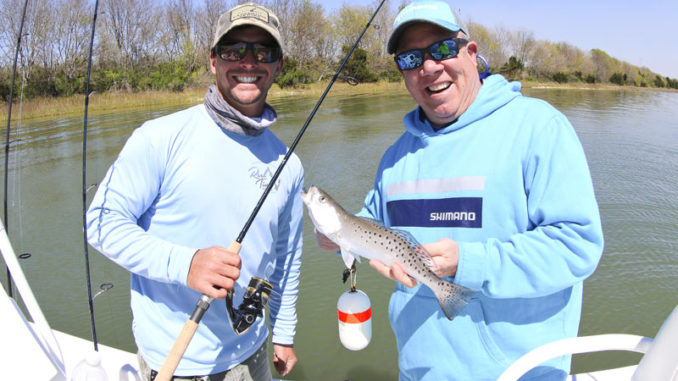
Colder weather means slowing lure, bait presentations
December offers inshore anglers a lot of open water, because many folks would rather stay indoors. But those who don’t mind the cold will find plenty of fish willing to bite. It’s true that cold slows fish down. But they still eat, and you can catch your share by adjusting your tactics to meet their level of activity.
The fish slow down, so as anglers, we should, too.
Some anglers use a three-pronged approach this month, starting off by slowly working topwater lures, then switching to suspending lures, then using cut bait as the sun gets up.
Many anglers overlook popping lures for inshore fish. But they are perfect for winter fishing. Unlike “walk-the-dog” type lures, poppers can be twitched once, then left to sit still for 10 seconds or longer. That’s just what you need to entice slow-moving speckled trout and redfish. Faster lures like Super Spooks must be worked fairly quickly to get the right action. And that gets them out of the strike zone too quickly this time of year.
Perfect poppers for inshore fishing
Popping lures, like the Rebel Pop-R, are designed to stay in the strike zone longer, and that’s perfect for inshore winter fishing. These lures offer the option of a feather-enhanced rear treble hook, which is a great option for cold water. As the lure sits still between twitches, the feather moves ever so slightly, giving the impression of a living baitfish.
Popping lures can be effective over any depths, especially when worked above flooded oyster rakes and along grass lines. Working them slowly is the key. However, if it’s an unseasonably warm day, or if the fish are being unusually aggressive, popping lures can also be walked in a zig-zag motion very similar to regular walk-the-dog type lures.
Suspend reality
Suspending lures like the Badonk-A-Donk are also great winter offerings. Anglers can work them as slowly as they want, and their ability to suspend in the water column can trigger strikes from fish that aren’t committing to topwater lures. A slight twitch followed by a long pause, or a few sharp twitches followed by a pause, can prove too much for specks and redfish to resist.
As with popping lures, working these suspending lures above flooded oysters is always a great option. Using them around the mouths of feeder creeks — or even cast into those creeks and worked out to the main waterway is also good.
Bait busters
Another good option involves a more passive way of fishing, but it is just as effective. Cut bait fished on the bottom works wonders. It doesn’t require fish to exert any effort to chase it down, and it gives off plenty of smell. The smell is the main attractant, unlike the two lure types mentioned above, which rely mainly on movement to entice strikes.
Any kind of cut bait works pretty well in December. One thing to remember is that bigger isn’t always better, and that’s especially true when the water is cold. The few baitfish that are present throughout the winter are generally small, so it’s best to stick with smaller baits. That also goes for the lures mentioned above, which are available in a variety of sizes.
Traditionally, anglers have used Carolina rigs to keep their bait in place, but a growing number of anglers are opting to use jigheads instead. This cuts down on the amount of terminal tackle needed, and it also allows anglers to use less weight. That makes for less-noisy presentations and more-accurate casting toward downed trees and sunken debris, which often holds black drum as well as redfish and trout.
Add odor to lures when fishing inshore
While cut bait has built-in odor, popping and suspending lures lack this feature. But artificial scents like Pro-Cure Super Gel will give those lures that missing piece of the puzzle. You might think these products would immediately wash off once the lure hits the water, but they go on thick and stay put for quite a while.
Pro-Cure is made of 100% baitfish, so the smell is natural. Sometimes it adds that extra touch that will convince curious fish to take a bite. It’s not uncommon this time of year for fish to follow a topwater or suspending lure all the way to the boat, then swim away without striking at it. Adding scent can often seal the deal on these wary fish.





Be the first to comment